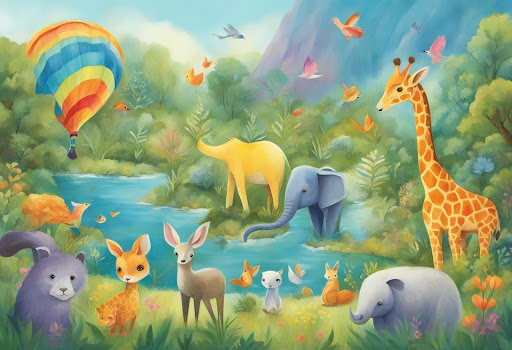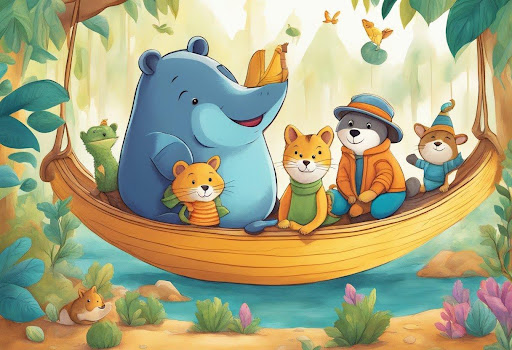Mastering illustration techniques for children’s books requires a unique set of skills and knowledge. Illustrators must be able to create captivating images that not only complement the text but also engage young readers if they want to learn how to become a children’s book illustrator. The illustrations must be able to convey emotions and actions in a way that is easy for children to understand.
One of the key skills for children’s book illustrators is the ability to draw. This involves not only the technical ability to create accurate and detailed images but also the creativity to bring characters and scenes to life. Additionally, illustrators must have an understanding of composition, color theory, and character development. They must be able to use these elements to create images that are both aesthetically pleasing and effective at conveying the story.
Another important aspect of illustrating children’s books is the ability to work collaboratively with the author and publisher. Illustrators must be able to take direction and incorporate feedback while still maintaining their artistic vision. They must also be able to meet deadlines and work within the constraints of the publishing process. With the right combination of skills and knowledge, illustrators can create illustrations that capture the hearts and imaginations of young readers.
Fundamentals of Children’s Book Illustration

Understanding the Role of Illustrations
Illustrations play a vital role in children’s books, as they help to bring the story to life and engage the reader. They can be used to convey emotions, set the tone of the story, and provide visual context for the text. It is important for illustrators to understand the role of their illustrations in the overall storytelling process and to work closely with authors to ensure that their illustrations complement the text.
Developing a Unique Illustrative Style
Developing a unique illustrative style is essential for standing out in the competitive world of children’s book illustration. It is important to experiment with different techniques and materials to find a style that is both visually appealing and appropriate for the target audience. Inspiration can be found in a variety of sources, such as nature, art, and other children’s books.
Essential Tools and Materials
The tools and materials used in children’s book illustration can vary depending on the artist’s preference and the specific project requirements. However, some essential tools and materials include a sketchbook, pencils, erasers, and colored pencils. It is important to choose high-quality materials that will produce long-lasting and vibrant illustrations.
In addition to traditional drawing and painting techniques, digital tools and software can also be used to create illustrations. It is important for illustrators to have a strong understanding of both traditional and digital techniques in order to create high-quality illustrations that meet the needs of the project.
Overall, mastering illustration techniques for children’s books requires a combination of technical skill, creativity, and collaboration with authors. By understanding the role of illustrations, developing a unique illustrative style, and using the right tools and materials, illustrators can create engaging and visually appealing illustrations that bring stories to life for young readers.
Creating Engaging Visual Narratives
Illustrating children’s books requires a combination of artistic talent, technical skill, and storytelling ability. An engaging visual narrative can capture a child’s imagination, help them learn, and inspire a lifelong love of reading. In this section, we will explore the process of creating captivating illustrations for children’s books.
Character Development and Design
Characters are the heart and soul of any children’s book. Developing memorable and relatable characters is essential to creating a successful visual narrative. Research is key to creating believable characters. The illustrator must understand the character’s personality, background, and motivations. This research will inform the design of the character, including their physical appearance, clothing, and accessories. Line work is also important in character design, as it can convey emotion and personality.
Setting, Mood, and Pace
The setting, mood, and pace of a children’s book are critical components of the visual narrative. The illustrator must research the setting and landscape of the story to create a believable world. Mood is conveyed through color, lighting, and composition. The pace of the story is also important, as it can affect the reader’s emotional response. The illustrator must consider the pacing of the story when creating the illustrations.
Storyboarding and Composition
Storyboarding is an essential part of the illustration process. It allows the illustrator to plan out the visual narrative and ensure that the story flows smoothly. Composition is also important in creating engaging illustrations. The illustrator must consider the placement of the characters, the use of negative space, and the overall balance of the image. Storyboarding and composition are critical to creating a successful visual narrative.
In conclusion, creating engaging visual narratives for children’s books requires a combination of artistic talent, technical skill, and storytelling ability. The illustrator must research the characters, setting, and pacing of the story to create a believable and engaging world. Storyboarding and composition are critical to planning out the visual narrative. By following these techniques, an illustrator can create captivating illustrations that inspire a lifelong love of reading.
Conclusion
 Mastering illustration techniques for children’s books requires a unique set of skills and a lot of practice. Aspiring illustrators should focus on developing their ability to draw, paint, or digitally create images, as well as an understanding of composition, color theory, and character development.
Mastering illustration techniques for children’s books requires a unique set of skills and a lot of practice. Aspiring illustrators should focus on developing their ability to draw, paint, or digitally create images, as well as an understanding of composition, color theory, and character development.
It is important to gather inspiration and brainstorm ideas before beginning the illustration process. Storyboarding and sketching initial concepts can help bring the story to life and refine the illustrations. Collaborating with the author and receiving feedback can also help improve the final product.
Using color to create emotion and bringing characters to life are essential skills for children’s book illustrators. By paying attention to composition and using collaboration and feedback to refine the illustrations, illustrators can create engaging and beautiful images that bring the story to life.
Overall, mastering illustration techniques for children’s books requires a combination of technical skill, creativity, and collaboration. With practice and dedication, aspiring illustrators can develop their skills and create illustrations that captivate young readers and bring stories to life.










